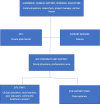Treatment barriers among young adults living with a substance use disorder in Tshwane, South Africa
- PMID: 36403019
- PMCID: PMC9675246
- DOI: 10.1186/s13011-022-00501-2
Treatment barriers among young adults living with a substance use disorder in Tshwane, South Africa
Abstract
Background: Despite increasing substance use globally, substance use treatment utilisation remains low. This study sought to explore and measure substance use treatment barriers among young adults in South Africa.
Methods: The study was done in collaboration with the Community-Oriented Substance Use Programme run in Tshwane, South Africa. A mixed methods approach employing focus group discussions with key informants (n = 15), a survey with a random sample of people using substances and receiving treatment (n = 206), and individual semi-structured interviews (n = 15) was used. Descriptive statistics and thematic analysis were used to analyse data.
Results: Contextual barriers seemed more prominent than attitudinal barriers in the South African context. Fragmented services, stigma-related factors, an information gap and lack of resources and support (contextual factors), perceived lack of treatment efficacy, privacy concerns, and denial and unreadiness to give up (attitudinal factors) were treatment barriers that emerged as themes in both quantitative and qualitative data. Culture and religion/spirituality emerged as an important barrier/facilitator theme in the qualitative data.
Conclusion: Interventions need to embrace contextual factors such as culture, and more resources should be channelled towards substance use treatment. Multi-level stakeholder engagement is needed to minimise stigmatising behaviours from the community and to raise awareness of available treatment services. There is a need for strategies to integrate cultural factors, such as religion/spirituality and traditional healing, into treatment processes so that they complementarily work together with pharmacological treatments to improve health outcomes.
Keywords: Help-seeking; Opioid substitution therapy; Substance use disorder; Treatment barriers; Young adults.
© 2022. The Author(s).
Conflict of interest statement
The authors declare that they have no competing interests.
Similar articles
-
Sub-Saharan African migrant youths' help-seeking barriers and facilitators for mental health and substance use problems: a qualitative study.BMC Psychiatry. 2016 Aug 2;16:275. doi: 10.1186/s12888-016-0984-5. BMC Psychiatry. 2016. PMID: 27484391 Free PMC article.
-
'I went for rehab many times and it never worked, but the harm reduction process has given me renewed hope'. Perceptions on the effectiveness of harm reduction and community-based opioid substitution therapy.Health Promot J Austr. 2024 Jul;35(3):653-661. doi: 10.1002/hpja.789. Epub 2023 Aug 22. Health Promot J Austr. 2024. PMID: 37605794
-
Mental health care providers' perceptions of the barriers to suicide prevention amongst people with substance use disorders in South Africa: a qualitative study.Int J Ment Health Syst. 2017 Aug 11;11:46. doi: 10.1186/s13033-017-0153-3. eCollection 2017. Int J Ment Health Syst. 2017. PMID: 28811835 Free PMC article.
-
"It's all about asking from those who have walked the path": Patient and stakeholder perspectives on how peers may shift substance use stigma in HIV care in South Africa.Addict Sci Clin Pract. 2022 Sep 21;17(1):52. doi: 10.1186/s13722-022-00330-5. Addict Sci Clin Pract. 2022. PMID: 36131304 Free PMC article.
-
Effective Nursing Recovery-Oriented Interventions for Individuals With Substance Use Disorder: A Literature Review.J Addict Nurs. 2022 Oct-Dec 01;33(4):233-246. doi: 10.1097/JAN.0000000000000489. J Addict Nurs. 2022. PMID: 37140411 Review.
Cited by
-
Identification of the socio-cultural barriers of drug addiction treatment in Iran.Heliyon. 2023 Apr 18;9(5):e15566. doi: 10.1016/j.heliyon.2023.e15566. eCollection 2023 May. Heliyon. 2023. PMID: 37131427 Free PMC article.
-
Feasibility and acceptability of a peer provider delivered substance use screening and brief intervention program for youth in Kenya.BMC Public Health. 2023 Nov 16;23(1):2254. doi: 10.1186/s12889-023-17146-w. BMC Public Health. 2023. PMID: 37974158 Free PMC article.
-
The Impact of Drugs and Substance Abuse on Viral Pathogenesis-A South African Perspective.Viruses. 2024 Jun 17;16(6):971. doi: 10.3390/v16060971. Viruses. 2024. PMID: 38932263 Free PMC article. Review.
References
-
- Harker N, Lucas WC, Laubscher R, Dada S, Myers B, Parry CD. Is South Africa being spared the global opioid crisis? A review of trends in drug treatment demand for heroin, nyaope and codeine-related medicines in South Africa (2012–2017) Int J Drug Policy. 2020;1(83):102839. - PubMed
-
- Minnaar A. The supply, demand, trafficking and smuggling of drugs in South Africa: a situational review. Acta Criminologica: Afr J Criminol Victimol. 2015;1:1–28.
-
- Bornman J, Nelson Bryen D, Kershaw P, Ledwaba G. Reducing the risk of being a victim of crime in South Africa: you can tell and be heard! Augment Alt Commun. 2011;27(2):117–130. - PubMed
MeSH terms
LinkOut - more resources
Full Text Sources
Medical
Miscellaneous


